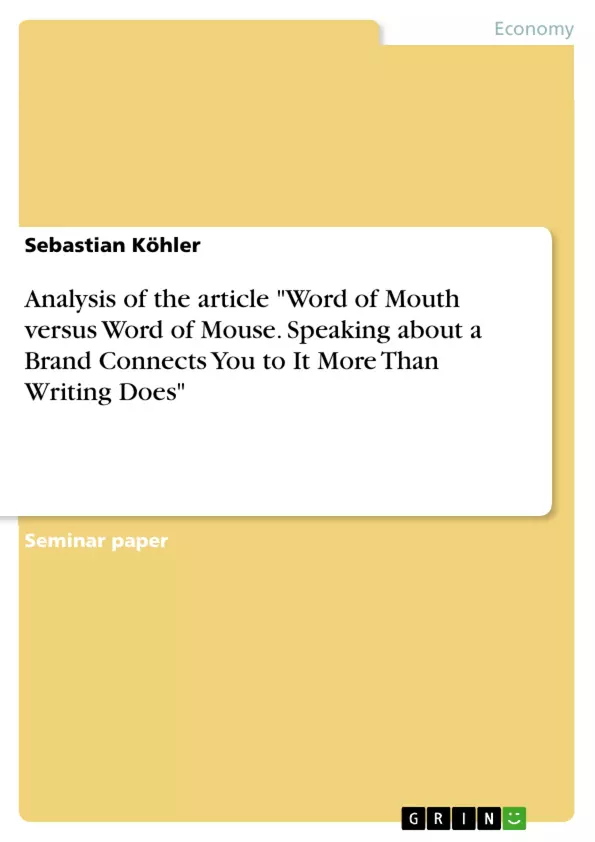The aim of this paper is to shed light on the various ways in which traditional word of mouth (WOM) and electronic word of motuh (eWOM) influence consumer behaviour in terms of the resulting SBC, brand loyalty, self-enhancement and vice versa. In addition, consumers' subsequent reactions after their behaviour has been influenced by the different ways of communication are portrayed.
Accordingly, the classification of the topic in the field of marketing research and the definitions of central terms and concepts are determined in the first step. Then, the paper will provide an overview of the current state of research regarding the topic in chapter three. Subsequently, chapter four demonstrates an in-depth presentation of the article "Word of Mouth versus Word of Mouse: Speaking about a Brand Connects You to It More Than Writing Does" written by Hao Shen and Jaideep Sengupta. When discussing the article's main findings in more detail, this study will particularly present its objectives, data basis used, methods, findings and limitations. Finally, it concludes with some reflections on possible implications for practitioners and researchers and will give an outlook toward further research contexts.
Table of Contents
- Introduction
- Conceptual Foundation of Research
- Brand Loyalty
- Self-Enhancement
- Self-Brand Connection
- Traditional WOM and eWOM
- Overview of the Current State of Research
- Detailed Presentation of the Article
- Discussion
Objectives and Key Themes
This seminar paper aims to explore the relationship between word of mouth (WOM) and electronic word of mouth (eWOM) communication and their impact on brand loyalty. The focus is on understanding how self-brand connection influences consumer behavior and the role of both traditional and online communication channels in building and maintaining brand loyalty.
- The impact of WOM and eWOM on brand loyalty
- The influence of self-brand connection on consumer behavior
- The role of traditional and online communication channels in building brand loyalty
- The interplay between self-enhancement and brand loyalty
- The current state of research on WOM and eWOM
Chapter Summaries
- Introduction: The introductory chapter establishes the background and purpose of the seminar paper, outlining the key research question and the overall focus on the relationship between WOM and eWOM and brand loyalty.
- Conceptual Foundation of Research: This chapter delves into the theoretical framework underpinning the study, examining key concepts such as brand loyalty, self-enhancement, and the connection between self and brand. It also introduces the distinction between traditional WOM and eWOM, highlighting their unique characteristics and impact on consumer behavior.
- Overview of the Current State of Research: This chapter provides a comprehensive overview of existing research related to the topic, summarizing key findings and identifying gaps in knowledge. This review serves as a foundation for the subsequent analysis and discussion.
- Detailed Presentation of the Article: This chapter focuses on a specific article chosen for in-depth analysis, presenting the key arguments, methodology, and findings of the study. This detailed examination provides insights into the relationship between WOM and eWOM and their influence on brand loyalty, taking into consideration the concept of self-brand connection.
Keywords
This seminar paper centers around the key concepts of word of mouth (WOM), electronic word of mouth (eWOM), brand loyalty, self-brand connection, self-enhancement, traditional and online communication channels, consumer behavior, and the current state of research on these topics.
- Citation du texte
- Sebastian Köhler (Auteur), 2020, Analysis of the article "Word of Mouth versus Word of Mouse. Speaking about a Brand Connects You to It More Than Writing Does", Munich, GRIN Verlag, https://www.grin.com/document/1177084



